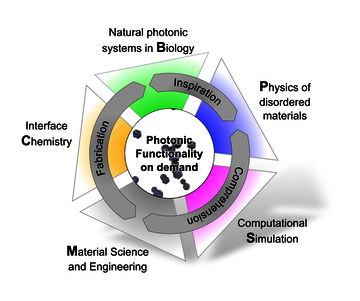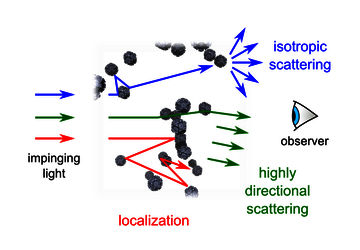SPP 1839 „Tailored Disorder“
The priority programme “Tailored Disorder - A science- and engineering-based approach to materials design for advanced photonic applications” (SPP 1839) is an effort to develop this novel field of research and foster new technologies to fabricate large scale materials with defined photonic properties based on deliberately and controlled disorder. Therefore, the SPP 1839 relies on the interplay of five research areas:

- Biology: Investigations of the composition and organization of biologically evolved photonic structures and their resulting photonic properties.
- Physics: Photon diffusion and scattering in disordered media and their collective effects.
- Theory and Computer Science: Modeling and simulation of disorder-based artificial or bio-genic photonic structures.
- Material Science: Fabrication of artificial or bio-mimetic structures that utilize disorder to define their functionality.
- Chemistry: Chemical functionalization or syntheses that facilitate control over the formation of disorder.

Three major effects can emerge in disordered media: (i) isotropic scattering, which is potentially useful for light sources without directed emission, (ii) highly directional scattering, which despite disorder minimizes demand towards material spatial accuracy (cost-effective) and (iii) localization, which slows down light or can even trap photons inside the disordered structure. This leads to cavity-like behavior useful for tailored interaction with secondary material effects, e.g. gain for lasing. All these effects can in addition be highly wavelength dependent and can be controlled by the many degrees of freedom inside a tailored disorder photonic material, promising a nearly unlimited freedom to tailor photonic responses.
The SPP 1839 is established by the Deutsche Forschungsgemeinschaft (DFG, German Research Foundation) since 2014. The program is designed for running up to six years.
Official programme description
The SPP “Tailored disorder – A science- and engineering-based approach to materials design for advanced photonic applications” investigates photonic properties of material composites with deliberately introduced irregularities in their geometry and composition. From fundamental scientific questions to various subfields of material science required for technological implementation of optimized materials all aspects will be explored. By combining inspiration from biological systems, results from physics, chemical approaches and validation from simulation, together with material science and engineering the SPP will enable the design of novel advanced photonic materials. This will finally lead to custom-made devices for a variety of photonic applications, their performance related to tailored disorder within 3D micro- and nano-architectures.
Recent research shows strict periodicity in photonic devices not being the only possible way to implement a desired functionality and a defined degree of disorder can give rise to unforeseen optical effects. Tailored disorder in materials can therefore propose design guidance to produce resilient materials, fulfilling the requirements for multi-functionality in complex environments and application fields. However, there is a large gap between theoretical considerations and practically available materials and devices. Up to now, fabrication routes to tailor disorder in a material have been scarce. The objectives of the SPP comprise the successful production of materials containing a defined degree and type of disorder with predictable photonic properties resulting in technological demonstrators. The theoretical and artificial systems that have been identified so far are not only limited with respect to property and performance control, but are also too expensive for any widespread technological implementation. Thus, new fabrication approaches and synthetic routes are required to merge scientific innovation and understanding with advanced engineering strategies.
One of the major goals is the identification of nano-architectures in biological systems, which produce a specialized optical response by means of disordered photonic structures e.g. in butterflies and beetles. The selective refraction and diffraction of light will subsequently be studied experimentally and theoretically with emphasis on (dis)order and (ir)regularity, identifying possible blueprints for artificial, bio-inspired nano-architectures. Finally the most promising approaches will be experimentally replicated via lab-based nano-fabrication.
To advance this field beyond pure observation, a truly interdisciplinary approach is taken relying on (i) biological blueprints followed by (ii) bio-inspired replication and (iii) ultimately identification of design rules for artificial synthesis/-patterning and optimization of photonic nano-architectures with tailored disorder.